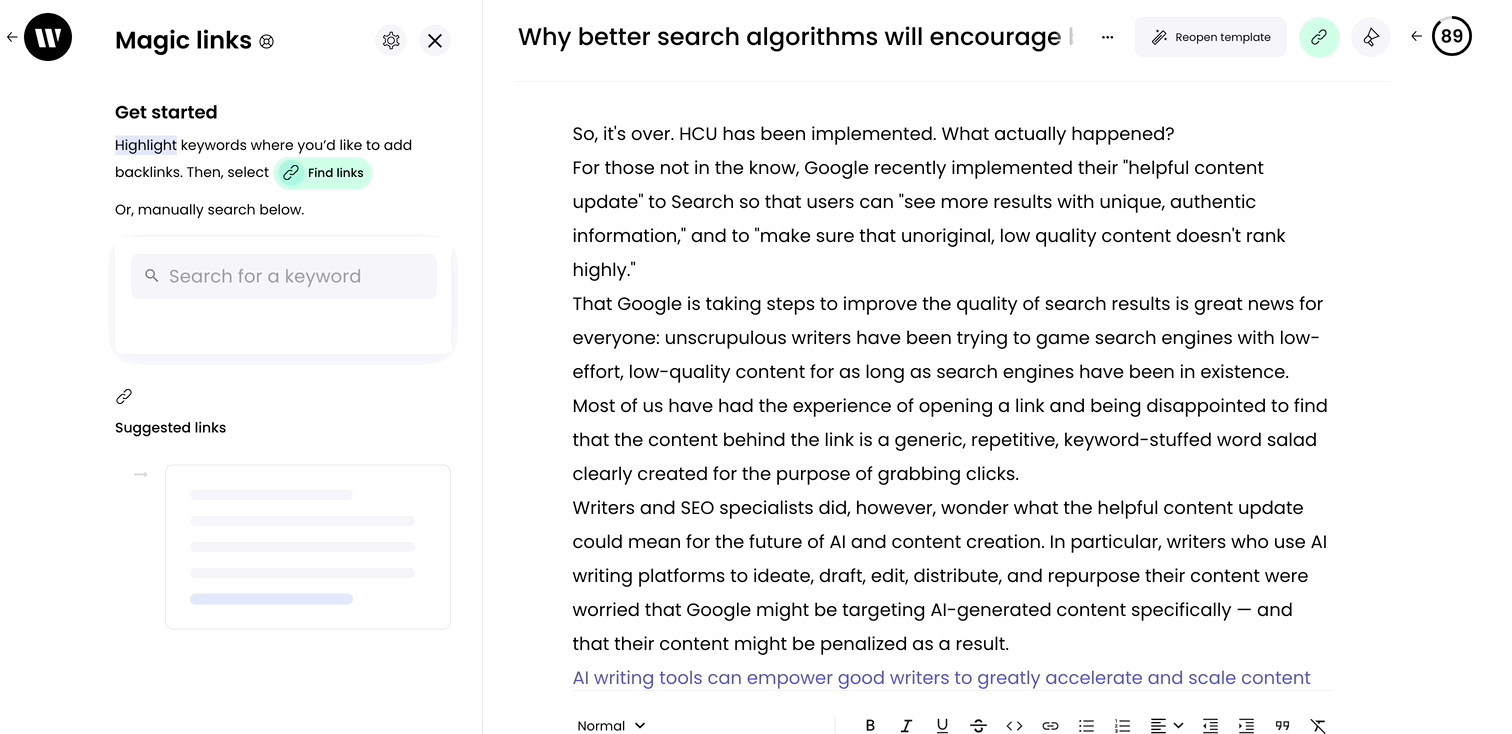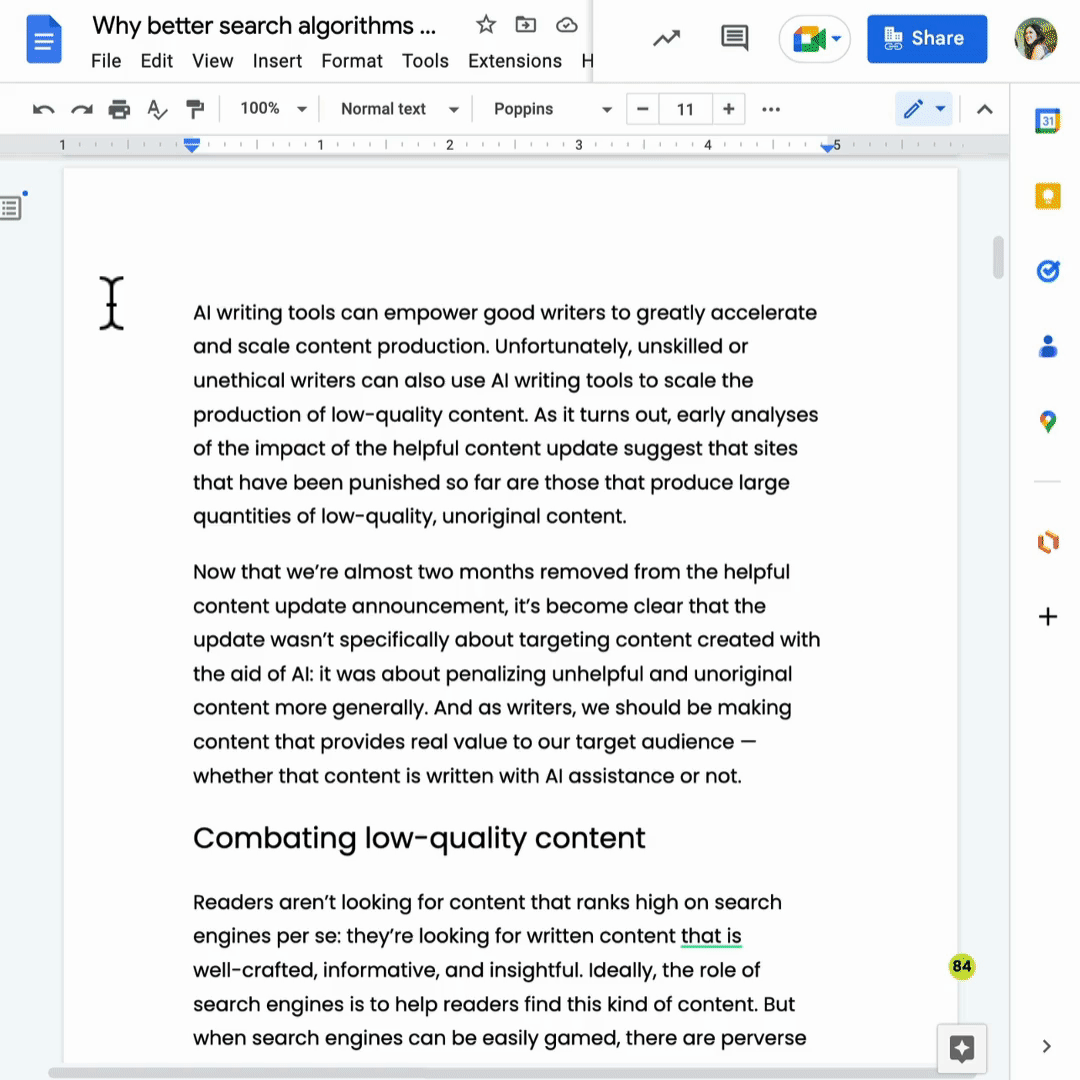AI in action
– 11 min read
Why you can’t replace human insight: The importance of editorial skills in the AI era

AI-generated content without proper editorial oversight is like relying on a toddler to handle your taxes — it’s bound to end badly. While AI has revolutionized content creation, it’s no match for the editorial skills a professional human writer brings to their work: a critical eye, creative finesse, and ethical judgment. In the AI era, where algorithms excel at generating content, human writers and editors still reign supreme. They ensure accuracy, compliance, and inject the creativity and human connection that takes AI-generated content to the next level. In this article, we delve into why editorial skills are indispensable and share tips for harnessing the collaborative power of humans and AI in content creation.
- Skilled editors are critical for fact-checking, detecting and removing inappropriate content, maintaining voice and identity, and ensuring accuracy and quality
- Learn how to use AI to streamline and improve editorial processes
- Do a bias, plagiarism, and fact-check on all claims and stats in AI-generated content
- Add a human touch to all content generated by AI
- AI can help editors unlock new possibilities and maximize the potential of the profession
Why are editorial skills more crucial than ever in the AI age?
Skilled editors are like superheroes in the digital world. They can spot grammar errors and inaccuracies that even the most powerful AI programs can’t. Their skilled eyes and language knowledge make them invaluable to any organization. And they have the power to make sure that published content is of the highest quality. Let’s dive deeper into the reasons why skilled editors should be a part of any content production process.

Editors are important for fact-checking AI-generated content
Without proper editorial oversight, AI-generated content can contain inaccuracies or biases that could have real-world consequences for individuals or companies.
Take the case of CNET, a renowned tech news site that experienced a reputation-shattering blow when it was revealed that over half of its AI-written stories contained errors. Such missteps not only tarnish a company’s image but can also have severe legal repercussions. Plus, AI-generated content spreading propaganda about individuals or groups may incite public outrage or cause harm.
Therefore, editors are important for fact-checking AI-generated content to make sure it’s accurate and not misrepresented. They also play a key role in examining content for potential legal and ethical issues such as copyright infringement, privacy violations, misrepresentation, or any form of bias or discrimination.
Quality assurance is an essential part of the editing process
Editorial skills are essential for assessing the quality of AI-generated content and making the necessary improvements. They need to check AI-generated content for accuracy, clarity, and relevance.
Additionally, editors also play an important part in checking that generative AI copy doesn’t repeat itself, and that content covers relevant and comprehensive topics.
Lastly, editors need to be able to identify and fix errors, typos, and inconsistencies. They need to have a strong knowledge of grammar, style, and the rules of writing.
Editorial skills are essential for maintaining voice and identity
AI-generated content doesn’t always account for the nuances of a brand’s personality and values and may produce content that misses the mark. That’s where editors come in. They can review, and edit the content for tone to ensure that it resonates with the audience and reinforces the organization’s messaging and objectives.
Editors also have a deep knowledge of the company’s product and content goals. And even if an editor doesn’t have knowledge of a topic, they can refer to a subject matter expert in their org to consult on their thoughts. As a result, they can uncover insights and add informed perspectives to content that represents their brand. This means they can talk about a company’s resources and features more authoritatively than generative AI, and introduce CTAs that fall in line with a cohesive content strategy.
To help scale your editorial efforts across teams and functions, you could opt for a solution like WRITER, which offers features that assist writers to maintain voice and messaging consistency. This means that you’re able to not only generate content with AI, but also personalize outputs to reflect your brand.
SEO optimization is an important part of the editorial process
SEO optimization is important for content to get noticed on search channels, drive traffic, and engage the audience. Editors can help make sure AI-generated content meets SEO best practices. This includes adding bullet points, relevant keywords and calls to action to optimize the content for search engines.
Another important SEO-best practice is to interlink content. While AI tools like WRITER magic links can help find internal linking opportunities to related articles, it’s the editor’s job to gauge if the content is actually relevant or helpful to the user. With their expertise, editors can improve the content’s chances of reaching the intended audience and maximizing its impact.

Good editorial skills can ensure AI-generated content is free of bias
While AI technology has advanced significantly, it lacks the critical thinking and decision-making abilities that humans have. This can lead to inaccuracies, biases, or blind spots in the generated content. In fact, researchers from the University of Southern California (USC), found bias in as much as 38.6% of the ‘facts’ generated by AI systems. By having human editors review and fact-check AI-written content, they can ensure that it’s free from bias and follows ethical standards. This helps to maintain the integrity of the content and build trust with readers.
AI-driven content lacks the creativity that humans bring to the table
Let’s not forget that AI doesn’t have a personality (yet!). Without an editor, AI-generated content can come across as robotic.
You see, a human editor can look at a piece of content, and come up with hundreds of ways to improve its engagement. For example, they can start an article with an interesting hook that captures the reader’s attention. Another example of editors making content multifaceted is when blogs are starting to look like a wall of words, they use visual elements to break paragraphs. Or, when comparing two products, they add a table for easier understanding and to make information more digestible.
While AI is great at producing content that’s informative, it often lacks the creative flair and engagement that humans bring to the table. With editorial oversight, humans can enhance AI-generated content with creative phrasing, humor, and other elements that’ll make it more interesting and engaging for readers.
Skilled editors ensure that content is tailored to the audience’s needs
Skilled editors are critical for understanding the audience and making sure that the content is tailored to the readers. They can refine and polish content, spot issues, and enhance consistency. This ensures that AI-generated content is audience-appropriate and achieves communication goals
6 tips for editing AI-generated content
Content is only as good as the editor who checks it. As AI-generated content becomes increasingly prevalent, strong editorial skills are essential to ensure the accuracy and quality of the content. Here are six tips for effortlessly editing AI-generated content:
1. Learn how to use AI to streamline and improve editorial processes
To ensure that your content is of the highest quality, it’s important to become familiar with the different types of editorial tasks that you can automate using AI. This includes tasks like formatting, finding and replacing words, spell-checking, and grammar-checking. For example, on top of being able to use WRITER for spell checking and for grammar and punctuation checks, content creators can also use the rewrite feature to polish, simplify, shorten, and enrich text.

This type of automation frees up time for more creative tasks that AI might not be able to do as well, such as storyboarding and developing content ideas, finding the right tone or style for a piece of content, or writing a catchy hook.
2. Create a brand style guide to ensure content is on-brand and high-quality
It’s important to create a brand-style guide with crystal-clear procedures and expectations for working with AI-generated content. This guide acts as your team’s North Star, providing precise protocols, guidelines, and best practices to ensure that all content meets the same quality standards. For example, it can include rules on what content is appropriate and when manual editing is necessary.
The brand style guide can also help define the tone of the content, as well as provide guidance on spelling, grammar, and punctuation.
3. Take a step-by-step approach to creating longform content
From a single prompt, AI can generate a blog or an eBook. Yes, that’s amazing – but there’s a catch. The more it generates, the more editing and fact-checking you’ll have to do. The trick is to take a step-by-step approach for longform content.
Start with a basic outline, whether it’s created by a human or generated by AI. This provides a structured framework to guide the content creation process. Then, use AI prompts or utilize features like the WRITER blog builder to fill in each section, adding depth and detail to the overall piece.
After that, review the content and ensure it flows well and follows your brand’s style guide. Finally, optimize the content for SEO, adding relevant keywords and phrases to make sure it can be discovered by the right people.
4. Check for bias, plagiarism and verify any AI-generated claims
To ensure that AI-generated content is accurate, ethical, and legal, you should consider the following practices:
- Be sure to check for any potential biases in the data.
- Double-check the accuracy of your content by running it through a plagiarism checker.
- If you aren’t a subject matter expert, ask one to review your draft for possible misinformation.
- Choose an AI writing tool with built-in claim detection to quickly scan for inaccuracies.
- Make sure that any data or statistics used are from reliable and trustworthy sources.
- Ensure that any content generated by AI is properly credited and licensed.
5. Add a human touch to all content generated by AI
Remember, AI is a tool to assist in the writing process. It’s not a replacement for the human mind, but rather an extension of it. So if you’re using AI to generate the first drafts of your blog posts, then you should add your own personal touch to the final draft. We live in a reality where AI can generate limitless amounts of content, and where human creativity is more valued than ever before.
Consider this your “humanize it” checklist for your AI-generated content:
- Stories from customers that are specific and relatable
- Metaphors and analogies to drive points across
- Create a narrative theme to make complex ideas simple
- Spicy takes or insights only your company can offer based on your product research
- Video or audio clips from SME interviews
- Comedy bits or songs to add a little fun to “boring” topics
- Custom iconographs or illustrations that visually represent your brand’s style
Your content should always include a little human touch, something that makes it relatable. Incorporating these elements will help make your content more engaging and relatable to your readers.
6. Train the AI model to help reduce the likelihood of false and unethical content
If trained on biased data, AI can produce harmful, misleading, and false output. It can also sometimes reproduce copyrighted material from its training dataset. Therefore, you should use an AI model trained to understand the specific context for which it’s used and how to adjust its output based on changes in the environment. This includes understanding the target audience, the purpose of the content, and the overall context of the content being generated. Additionally, you should have a feedback loop in your system to allow it to continually improve over time. This helps ensure that the system is producing the most accurate and ethical content possible.

WRITER offers teams real-time fact-checks with its Knowledge Graph feature. Knowledge Graph acts as your company’s information layer. It connects you with company data sources like product knowledge bases, company wiki pages, cloud storage platforms, and more. That way, you can fact-check generative AI output, research, and ask questions in real-time.

AI technology + human editorial skills = content excellence
Amid concerns of AI replacing human jobs, the reality is that the need for human editors is greater than ever. Their role in maintaining quality, mitigating bias, and ensuring accuracy remains indispensable in an AI-driven world. And editors who embrace and leverage AI technology can unlock new possibilities and achieve even greater excellence in their craft. AI, in fact, could be the missing link that enables editors to maximize the potential of their profession. By working together, editors and AI can help create more meaningful content for readers and audiences around the world.
Want to streamline your team’s writing process and publish with confidence? Give WRITER a try for free.